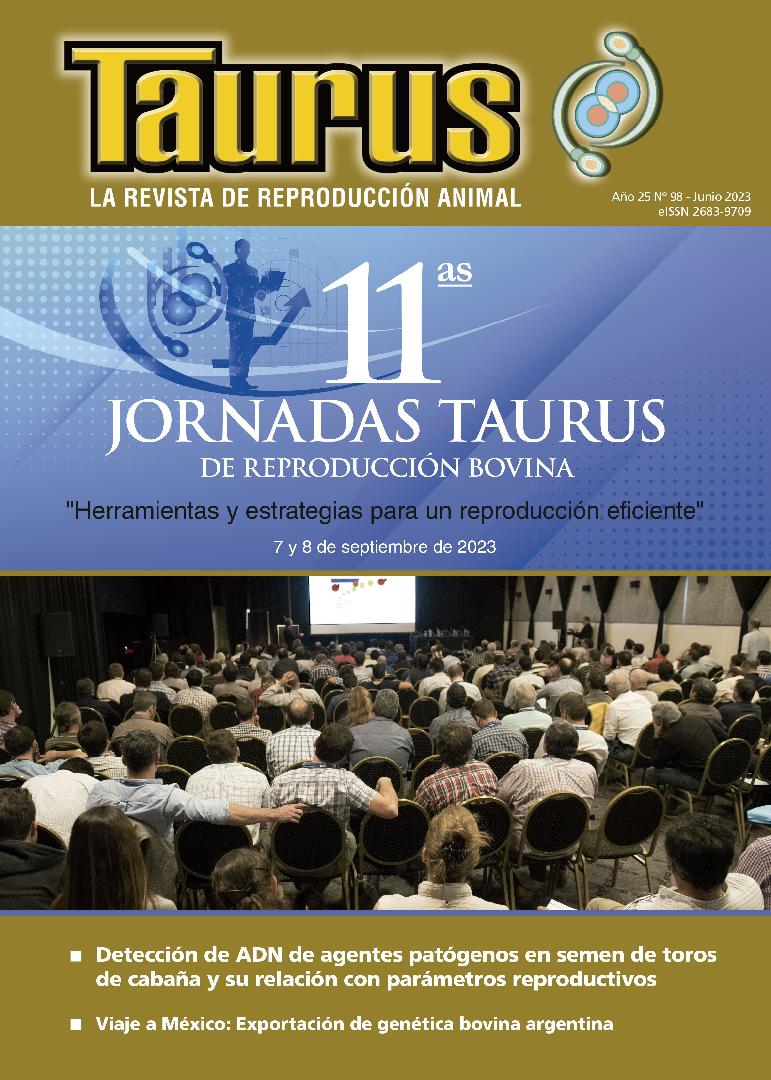Ver ítem
- xmlui.general.dspace_homeCentros Regionales y EEAsCentro Regional La Pampa - San LuisEEA AnguilArtículos científicosxmlui.ArtifactBrowser.ItemViewer.trail
- Inicio
- Centros Regionales y EEAs
- Centro Regional La Pampa - San Luis
- EEA Anguil
- Artículos científicos
- Ver ítem
Detección de ADN de patógenos en semen de toros de cabaño: relación con parámetros reproductivos
Resumen
El objetivo del estudio fue detectar mediante técnicas moleculares (PCR) la presencia de ADN de agentes pató-genos en muestras de semen fresco y evaluar su relación con los parámetros reproductivos y la fragmentación del ADN de los
[ver mas...]
El objetivo del estudio fue detectar mediante técnicas moleculares (PCR) la presencia de ADN de agentes pató-genos en muestras de semen fresco y evaluar su relación con los parámetros reproductivos y la fragmentación del ADN de los espermatozoides.
[Cerrar]
Argentine cattle breeding requires the incorporation of analyses that allow us to reduce the number of unfit bulls in the herds. The objective of the study was to detect the presence of pathogen DNA in fresh semen samples using molec-ular techniques (PCR) and to evaluate its relationship with reproductive parameters and sperm DNA fragmentation. Samples from a group of 24 asymp-tomatic bulls from 18 herds of Buenos Aires and La Pampa provinces were
[ver mas...]
Argentine cattle breeding requires the incorporation of analyses that allow us to reduce the number of unfit bulls in the herds. The objective of the study was to detect the presence of pathogen DNA in fresh semen samples using molec-ular techniques (PCR) and to evaluate its relationship with reproductive parameters and sperm DNA fragmentation. Samples from a group of 24 asymp-tomatic bulls from 18 herds of Buenos Aires and La Pampa provinces were ob-tained. The minimum scrotal circumference value was 33 cm. Twenty-one per-cent of the bulls showed low mating capacity. Ureaplasma diversum DNA was detected in 30.4% and DNA fragmentation was found in 16.6% of the sperma-tozoa. Significant differences were only found when comparing prevalences of
Ureaplasma diversum DNA detection and seminal volume (X2 = 8.39 p<0.05). No other studied pathogen DNA was detected. Incorporating techniques that allow us to evaluate seminal quality will allow us to reduce economic losses and the entry of risky genetic material.
[Cerrar]

Autor
Rojas, Maria Del Carmen;
Gelid, Lucas Fernando;
Vazquez, Pablo Mauricio;
Butti, Lucas Ramiro;
de la Mata, Carlos Arturo;
Baldone, Valeria Natalia;
Fuchs, Lumila Ivana;
de la Mata, Javier;
Fuente
Taurus 25 (98) : 18-32 (2023)
Fecha
2023-06-01
Editorial
Ediciones Taurus
ISSN
1515-3037
2683-9709
2683-9709
Documentos Relacionados
Formato
pdf
Tipo de documento
artículo
Proyectos
(ver más)
INTA/2019-PD-E5-I103-001, Desarrollo de tecnologías diagnósticas y estudios epidemiológicos para el control de enfermedades que afectan la producción animal y la salud pública
Palabras Claves
Derechos de acceso
Restringido
 Excepto donde se diga explicitamente, este item se publica bajo la siguiente descripción: Creative Commons Attribution-NonCommercial-ShareAlike 2.5 Unported (CC BY-NC-SA 2.5)
Excepto donde se diga explicitamente, este item se publica bajo la siguiente descripción: Creative Commons Attribution-NonCommercial-ShareAlike 2.5 Unported (CC BY-NC-SA 2.5)


